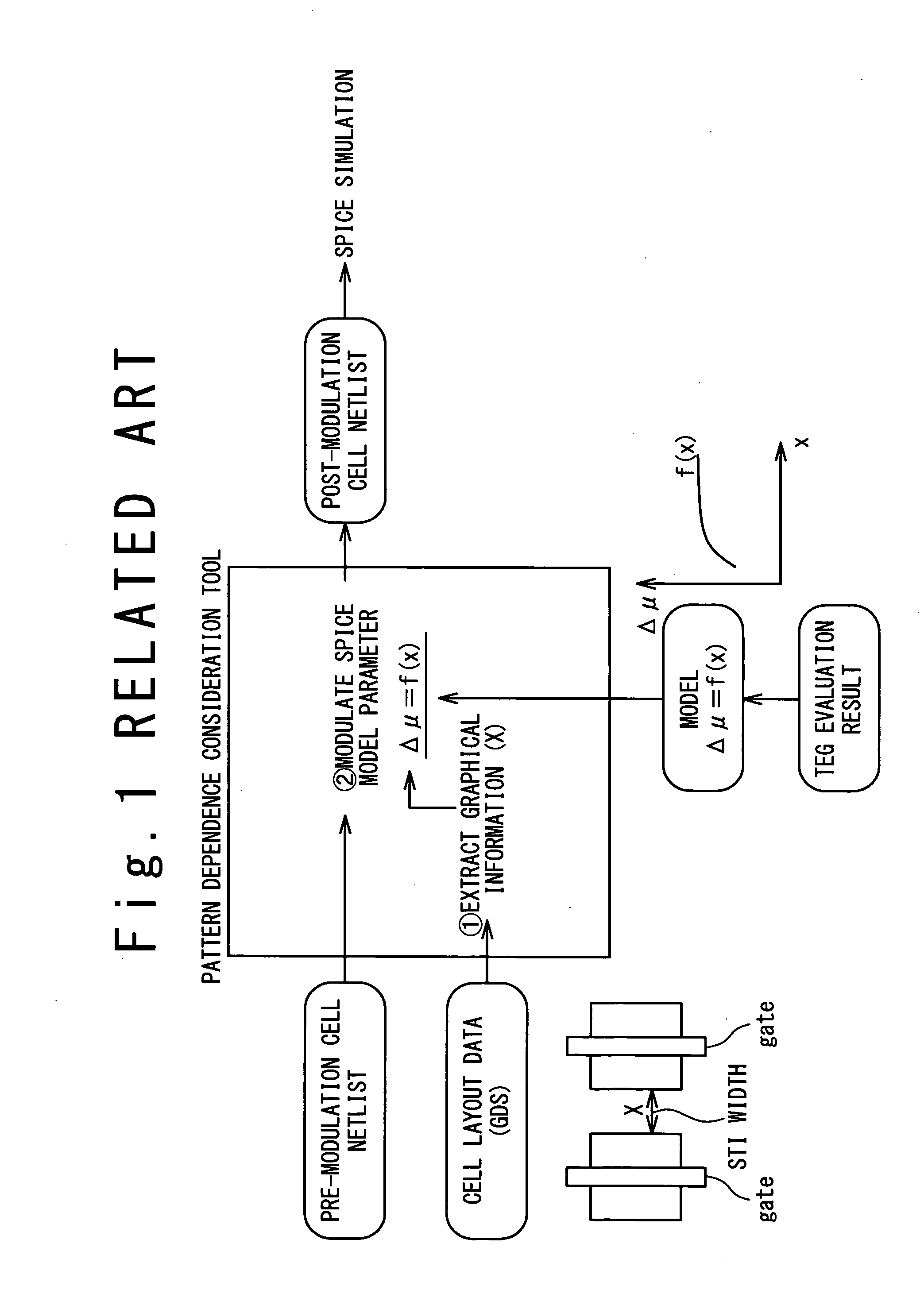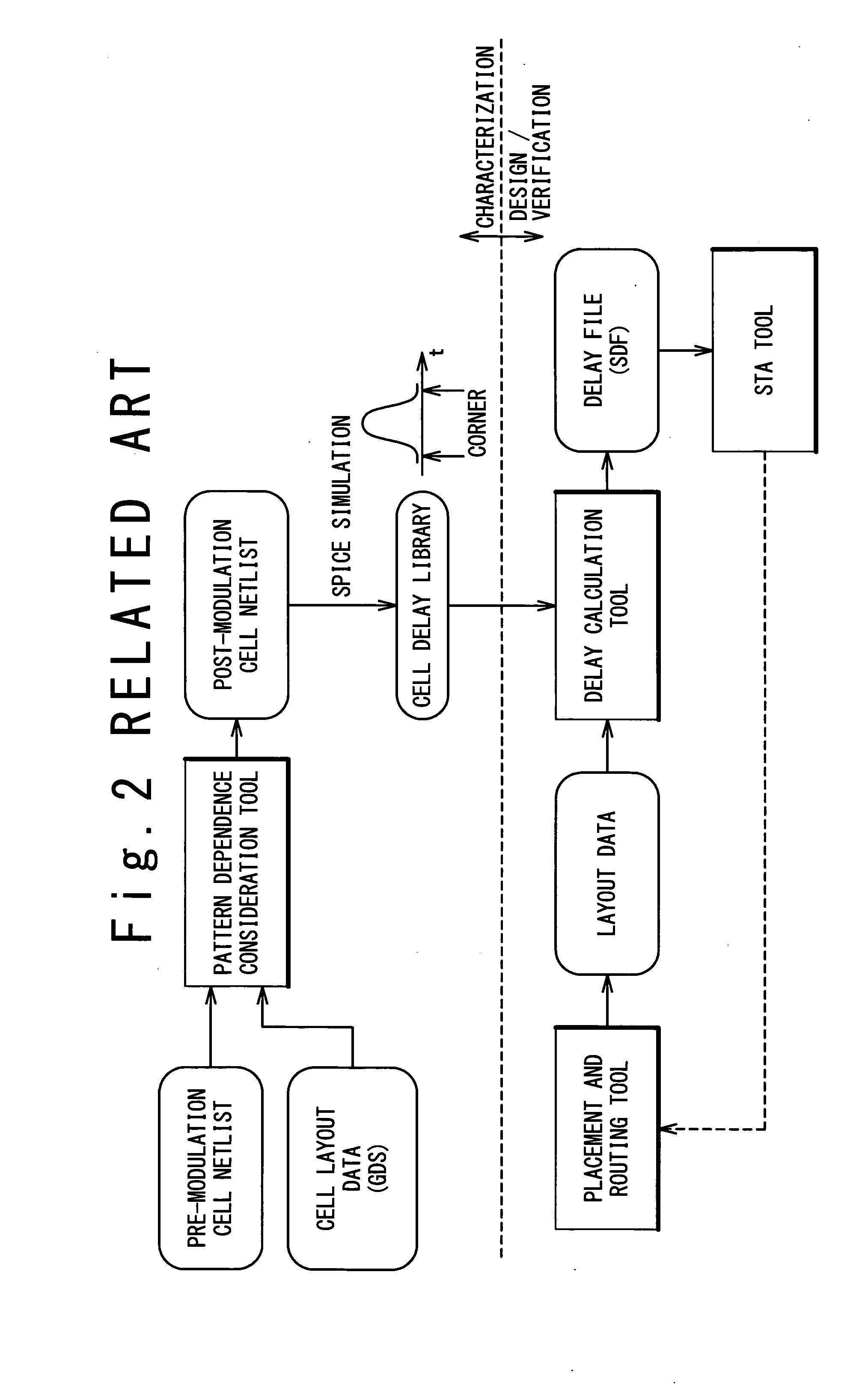Method and program for designing semiconductor integrated circuit
a technology of integrated circuits and integrated circuits, applied in the direction of program control, cad circuit design, instruments, etc., can solve the problems of not being able to module the spice model parameter of pmos transistors pb>1, not being able to consider the dependence of peripheral patterns in spice simulation, and preventing the increase of design/verification ta
- Summary
- Abstract
- Description
- Claims
- Application Information
AI Technical Summary
Benefits of technology
Problems solved by technology
Method used
Image
Examples
first example
4-1. FIRST EXAMPLE
[0100]FIG. 10 is a block diagram showing a first example of a method of generating the delay file SDF. The pattern dependence consideration tool 10 reads the pre-modulation cell netlist D11 of the target cell and the layout data LAY generated in the foregoing Step S20. Then, the pattern dependence consideration tool 10 modulates the pre-modulation cell netlist D11 based on the layout data LAY.
[0101]More specifically, the pattern dependence consideration tool 10 extracts the peripheral parameters (gate pitch and STI width) associated with the target transistor included in the target cell, from the layout data LAY (Step S31). In particular, the pattern dependence consideration tool 10 extracts the peripheral parameters (PGP_L, PDS_L, PGP_R, PDS_R, NGP_L, NDS_L, NGP_R and NDS_R) associated with the outermost transistors (e.g. P1, P3, N1 and N4 in FIG. 5) placed at the outermost in the target cell.
[0102]Subsequently, the pattern dependence consideration tool 10 modulat...
second example
4-2. SECOND EXAMPLE
[0105]FIG. 11 is a block diagram showing a second example of a method of generating the delay file SDF. In the present example, the delay calculation tool 30 includes a conventional delay calculation tool 30-0 and a variation calculation tool 31. The delay calculation tool 30-0 generates a delay file SDF-0 as usual based on the layout data LAY and the statistical STA delay library LIB. That is, the delay calculation tool 30-0 generates the delay file SDF-0 without calculating the delay variation Δt. The delay file SDF-0 indicates the reference delay value t of each cell and the path delay values.
[0106]The variation calculation tool 31 calculates the above-mentioned delay variation Δt based on the statistical STA delay library LIB and the post-modulation cell netlist D30. Then, the variation calculation tool 31 reads the delay file SDF-0 and modifies the delay file SDF-0 by using the delay variation Δt. In other words, the variation calculation tool 31 reflects the...
third example
4-3. THIRD EXAMPLE
[0107]In the third example, the model parameter modulated by the pattern dependence consideration tool 10 does not match the model parameter treated by the statistical STA delay library LIB. In this case, it is necessary to convert the modulation amount of the model parameter output from the pattern dependence consideration tool 10 into a modulation amount of an appropriate model parameter.
[0108]For example, let us consider a case where variations of only gate length L and gate width W among the SPICE model parameters are considered in the statistical STA delay library LIB. In this case, the delay function expresses the cell delay value as a function of a gate length variation ΔL and a gate width variation ΔW (t=f (ΔL, ΔW)). Meanwhile, the modulation target parameters in the pattern dependence consideration tool 10 are mobility μ0 and threshold voltage VT0 among the SPICE model parameters. The modulation amounts of the model parameters μ0 and VT0 are Δμ0 and ΔVT0, ...
PUM
 Login to View More
Login to View More Abstract
Description
Claims
Application Information
 Login to View More
Login to View More - R&D
- Intellectual Property
- Life Sciences
- Materials
- Tech Scout
- Unparalleled Data Quality
- Higher Quality Content
- 60% Fewer Hallucinations
Browse by: Latest US Patents, China's latest patents, Technical Efficacy Thesaurus, Application Domain, Technology Topic, Popular Technical Reports.
© 2025 PatSnap. All rights reserved.Legal|Privacy policy|Modern Slavery Act Transparency Statement|Sitemap|About US| Contact US: help@patsnap.com



